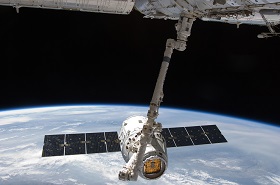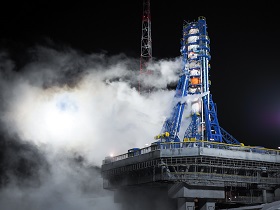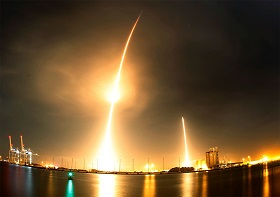Cosmonautics Day provides a good opportunity to pause and reflect on the prospects of astronautics not just from the Russian perspective but in terms of humanity in general. The April 12, 1961 launch of Yuri Gagarin’s spacecraft began the era of manned spaceflight, thus allowing us to honor the date as Cosmonautics Day. Back in the 1960s, the industry’s rapid development would have suggested that the incessant achievements would keep coming forever, and that outer space would soon be conquered, including in the form of manned missions to planets within the Solar System in the foreseeable future. Now, 67 years later, we must acknowledge that the space industry is stagnating. Most of the modern technologies currently being employed in space exploration are in fact modified technologies of the 1960s. Advanced projects such as the U.S. Space Shuttle program have been shut down, and the prospects of their resurrection are unclear.
The prospects of militarizing space are even vaguer. Until now, space has been used as an auxiliary theater of operations, with the existing space information systems supporting the ground, naval, and airborne components. Experimental anti-satellite systems, such as the Soviet program IS or the U.S. ASAT, still remain “very high-reaching anti-aircraft guns” rather than combat spacecraft. The question of whether a full-fledged weapons system comprising autonomous space-based interceptors can be created remains a moot point. On the other hand, should such a system be created it could undermine the existing strategic stability system.
Two Foundations of Strategic Stability
From the very beginning, space exploration has been closely linked to nuclear proliferation. This process has two dimensions: vertical, i.e. the quantitative and qualitative development of nuclear arsenals, and horizontal, i.e. the increase in the number of nuclear powers. If we compare the development mechanisms of the two sectors, we will see that both space exploration and nuclear proliferation were children of global politics and fundamental science.
Nuclear physicists began their research in the early 20th century; around the same time, Konstantin Tsiolkovsky, a schoolteacher, had his fundamental work published that paved the way to applied astronautics. During the 1930s, nuclear physics research continued actively within laboratories, while small groups of Tsiolkovsky’s disciples in the USSR, Germany, the U.S., and France were already launching the first primitive rockets. These enthusiasts laid a substantial intellectual foundation for the subsequent breakthrough into space, but there were no technological capabilities yet for the implementation of their findings in practice. The nuclear physicists, for their part, made a quantum leap.
The creation of nuclear weapons was a product of the political crisis that resulted in World War II, and of a coincident breakthrough in nuclear research. Space exploration resulted from the convergence of science and the Cold War, another phenomenon in international relations. One powerful impetus for space exploration was the need to overcome enemy air defenses from above, which transpired during the Cold War. As a result first ideas for the creation of “invulnerable aircraft” emerged shortly after the end of WWII. However, the impossibility of achieving the requisite space velocities in practice postponed their implementation by a decade. As a result, the space breakthrough was spurred not by immediate security necessities but by considerations of political prestige, another important factor in the race between the two systems.
Both nuclear physics and space exploration started off as creative collaborations among scientists working from different countries: they were international networking projects of sorts, which had no single center of administration. After a certain threshold had been reached, governments needed to get involved, and not at their own initiative but rather at the scientists’ request (the Frisch-Peierls memorandum and Albert Einstein’s letter concerning the atomic industry, and James Van Allen’s letter concerning space). The space project stood out in this respect: as compared to pre-war times, after the war a suitable platform for the promotion of major international initiatives emerged in the form of the UN, which supported Van Allen’s proposal to institute the International Geophysical Year (previously, in the 1920s and 1930s, neither nuclear physicists nor space exploration pioneers had attempted to promote their ideas via the League of Nations).
This is not the only important similarity between the two sectors. The past five decades witnessed the emergence of a significant factor in global politics, one that could be notionally described as a nuclear space factor and, one level up, as a technology factor. Since every artificial tool has the properties of diffusion (spatial propagation) and qualitative perfection, and politics are a process of interaction, any of these factors can be represented as a matrix. The rows in such a matrix would reflect the creation – an application pair for each political tool, and its columns would reflect the action – a counteraction pair. As applied to the nuclear factor, the first row of the matrix would be filled by the nuclear proliferation and nuclear deterrence pair, and the second one by the counter-proliferation and counter-deterrence pair. All the elements of the matrix would be cross-linked.
The launch of the first satellite in 1957, which heralded the beginning of the space era, was in and of itself an important impetus for the creation of nuclear forces. The significance of that factor wore off over time, however. More importantly, the applied military dimension of space exploration was from the very beginning aimed at addressing the topical objectives of nuclear deterrence by ensuring the targeting of delivery platforms (with the help of reconnaissance, navigation, weather, and geodetic satellites) and nuclear command and control (communications and early missile warning satellites). Pretty soon, space came to be regarded as a deployment field for counter-deterrence forces. The first anti-ballistic missile (ABM) defense projects incorporating space-based elements date back to the 1960s in the U.S. (BAMBI) and to 1962 in the USSR (Sergei Korolev’s Orbital Belt). At the same time, ground-based ABM interceptors were originally viewed as having an additional function: to destroy low-orbit satellites.
The 1963 Partial Test Ban Treaty and the 1967 Outer Space Treaty contributed greatly to strategic stability on Earth by effectively precluding the creation of area-type ABM systems, which back then were only pictured as something utilizing interceptor missiles tipped with powerful nuclear warheads (the U.S. Nike-X and the Soviet Taran). The two agreements facilitated the drafting of the Anti-Ballistic Missile Treaty, which became a cornerstone of strategic stability for the subsequent three decades.
However, despite the fact that the term strategic stability was broadly used throughout the 1970s and 1980s, it was not legally codified until after the end of the Cold War, and then in close connection with the nuclear and space factors. For this to become possible, the two nations had to go through another cycle of interaction in the space segment of national security in the 1980s. This included the Star Wars period involving America’s Strategic Defense Initiative (SDI) and the Soviet response which, as is now known, was not merely “asymmetric.” (It’s enough to recall the 1987 tests of a mock-up for the Soviet Skif DM combat space station.)
Since then, outer space militarization has not seen any practical implementation. The deployment of the U.S. ABM system has so far been limited to ground-based interceptors – essentially the same old “very high-reaching anti-aircraft guns”. Projects to create a space-based ABM component enjoyed a revival in the mid-2000s but have not yet resulted in anything tangible. The state of anti-satellite weapons is equally lamentable: Russia and the U.S. are still working with developments from the 1970s, whereas China in 2007 tested a first-generation system. The fact that the superpowers have put their space missile programs on ice indicates that they hardly have the technology required for a new breakthrough in space militarization (even though experts considered such a breakthrough all but imminent back in the mid-2000s).
A Technology-less Race
The space powers attempted technological breakthroughs in space exploration in the early 21st century. They were motivated by the successes of China, the only space-capable country that is not a party to the International Space Station program. China orbited an automated freighter in 2003, followed by its first manned mission. The latter demonstrated Beijing’s capability of delivering an intercontinental nuclear charge. China’s achievements catalyzed the space programs of other countries, from India and Brazil to New Zealand and Iran.
Washington reacted nervously to Beijing’s progress. On January 14, 2004, the George W. Bush administration announced a new space exploration program that involved expedited research of Solar System planets and manned missions to the Moon and Mars. Russia, the ESA, China, and even Japan followed suit with major space programs of their own. Experts began talking about a second space race, hinting at the Soviet-American rivalry of the 1960s.
For a number of years, the space powers attempted to behave in the spirit of the 1960s. They engaged in heated competition over who would be first to explore the surfaces of the Moon, Mars, Venus, Mercury, the gas giants, and even the Sun itself. In near space, Russia resumed the deployment of its GLONASS navigation system that had been suspended in 1995. Other countries came up with similar indigenous systems: Galileo (ESA), BeiDou (China), Quasi-Zenith (Japan), and IRNSS (India). The rivalry was piggybacked by a race of military programs, from the Bush administration’s idea to set up a space-based ABM echelon to the U.S. and Chinese tests of anti-satellite munitions.
By the early 2010s, everything had changed. On June 1, 2009, Barack Obama’s administration created the Review of United States Human Spaceflight Plans Committee chaired by Norman Ralph Augustine, the former CEO of Lockheed Martin. In October 2009, Augustine’s Committee presented a report to the effect that (1) missions beyond the Earth’s orbit would require extensive funding and (2) the time gap between the decommissioning of the Space Shuttle spacecraft and the start of launches of the new Orion vehicles would be at least seven years.
Russia also had its share of space mishaps. Three GLONASS satellites were lost in the December 5, 2010 Proton-M Launch. The August 18, 2011 launch of the Ekspress-AM4, another GLONASS satellite, also flopped. The situation worsened after the November 9, 2011 loss of the Phobos-Grunt sample return mission destined for one of Mars’s satellites. In December 2011, President Dmitry Medvedev instructed Deputy Prime Minister Dmitry Rogozin to inspect the country’s space agency Roscosmos.
These misfortunes served as a contrasting background for the successes of the newcomers to space. China performed a manned flight and launched a Moon surface probe. India orbited a constellation of polar satellites and launched a space probe of its own. The ESA created small satellites to map the surfaces of the Moon, Mars, and Venus. All these, however, were replications of the Soviet and U.S. achievements of the 1960s (or the early 1970s at best). None of the aforementioned space agencies has so far progressed to even the second stage of the erstwhile Soviet and U.S. research, namely the creation of space stations and/or reusable manned spacecraft.
The so-called second space race was a political imitation rather than an actual space exploration competition. The leading space powers failed to even repeat the successes of 50 years ago. The U.S. failed to resurrect the Apollo Lunar module in order to once again visit the Moon. Russia failed to come up with equivalents of the Soviet Lunokhod Moon rover and the Mars and Venera series of surface-mapping probes, both of which had been used in the late 1970s. The Americans effectively failed to build a single full-fledged manned space station (Skylab was based on a modified Saturn-IBV stage, and was viewed by NASA as a partial space station or a space lab). Russia is still completing the Soviet-designed GLONASS system, and has not yet created an equivalent of the Mir space station. Both countries are running on leftovers from the previous decades, with Russia continuing manned flights on board Soyuz spacecraft and the U.S. exploring outer space with improved versions of the Pioneer and Voyager probes created back in the 1970s. On the other hand, Russia and the U.S. remain the only two countries that have the entire range of space research tools at their disposal.
This state of affairs harbors major problems. The space breakthrough of the 1960s became possible thanks to two factors. The first had to do with the massive introduction of natural and exact sciences in Soviet and U.S. academia. The second one implied government funding for major projects with long lead times. With all their superficial differences, both the USSR and the U.S. followed through with this model until the mid-1970s.
Both these factors are inapplicable today. Modern countries are increasingly incapable of mobilizing resources. The prevailing giant bureaucratic systems inevitably incorporate influential interest groups, whose primary goal it is to secure quick returns. Of no less importance is the electorate’s high sensitivity to overconsumption. As compared to the 1930s and 1940s, today’s voters are not prepared to suffer inconveniences for the sake of abstract space projects.
Changes in the quality of education present another problem. According to surveys, the level of instruction in natural sciences has dropped in the U.S., Russia, and particularly in the EU over the past 30 years. Traditional lectures and seminars are being replaced with learning-through-play methods and teaching-of-skills approaches. The result is obvious. Physicists are concerned that in the past 50 years, there have been virtually no major discoveries made in natural sciences that would be comparable in scale to the achievements of the first half of the last century.
The second space race was not marked by the development of a qualitatively new generation of space and rocketry technology. China, which had tapped into the Russian technological resources, launched its first man in orbit in 2003, started an unmanned Lunar research program in 2007, and tested an anti-satellite weapon also in 2007. Latin American countries have started developing various types of satellites, and Brazil even has a program to devise an indigenous suborbital launch vehicle. East Asian countries, India, Australia, and New Zealand are actively developing their rocketry sectors for the purpose of creating various types of launch vehicles and telecom satellites. Nevertheless, these projects are nothing bigger than attempts to replicate the Soviet and U.S. space programs of the last third of the past century.
The Phantom Menace
Having reviewed the past six decades of space exploration, it is apparent that the impact of space equipment on international security is rather complex.
On the one hand, spacecraft enhance security by supporting the enforcement of international treaties and helping build trust and transparency. In providing additional information to different sides in conflicts, spacecraft naturally reduce the possibility of a surprise attack, thus enhancing strategic stability as applied to both nuclear and conventional weapons. In addition, spacecraft are used for monitoring purposes in the course of UN peacekeeping operations and missions as well as in the interest of international security. Information provided by remote Earth sensing satellites is essential to mitigating the consequences of natural and man-made disasters.
On the other hand, spacecraft improve the efficiency of military muscle as a policy tool, providing additional advantages to those who are better versed in using such tools: first and foremost in the fields of command and control, stable communications, navigation, reconnaissance, and the application of precision munitions. This trend calls for reappraising space-based equipment as a possible destabilizing factor, given the direction in which technology is evolving.
Research into the militarization and weaponization of space as a threat to international security specifically focuses on conventional anti-satellite weapons. The test conducted by China in January 2007, and America’s response in February 2008, can also be described as conventional, but there are reasons to believe that the technologies used in both instances will no longer define the future of anti-satellite weapons. The reason: space debris generated by successful orbital intercepts. If we extrapolate available reports about the consequences of the 2007 Chinese test, we may presume that a sequence of several such intercepts will have littered the Earth’s orbit beyond the level comfortable for normal spacecraft operations, irrespective of origin and mission. This suggests that the era of kinetic anti-satellite munitions will soon end, just as the era of nuclear interceptors did before it. On the other hand, the first decade of the 21st century saw the emergence of new spacecraft types, those which are being closely watched by researchers but have not yet been appraised with regard to their impact on strategic stability and international security.
Little research has been done so far concerning the modern development trends of non-kinetic kill mechanisms, the obliteration of the boundary between military and civilian satellites, and the possibility of foreign spacecraft being tampered with under the pretext of “orbital cleanup.”
The emergence of new technologies additionally blurs the line between military and civilian spacecraft; the latter are increasingly enabled to perform as the former (including in kill roles) thanks to technological advances.
Such “dual-role” vehicles are above all low-observable maneuverable spacecraft designed for close-in inspections. Low observability is a valuable property for a non-kinetic kill vehicle, allowing it to steal up to a foreign spacecraft for inspection and possibly for non-destructive tampering. Low-observable spacecraft are mainly hearsay as no official information is available.
In the beginning of the 21st century, a new generation of maneuverable spacecraft were developed on orders from the U.S. Air Force: so-called microsatellites weighing up to 100 kg. Their official applications include close-in inspections, rendezvousing, and docking with other spacecraft. It should be noted that a Pentagon spokesperson commenting on the test flight of one such satellite (XSS-11) stated in no uncertain terms that the craft could also be used for orbital intercepts.
The small size of the new-generation inspection vehicles is fully in line with the new “swarm” deployment concept; work is in full swing in the U.S. to weaponize this concept for a variety of applications.
We should stress that one of the current activities being pursued by NASA (a civilian agency!) involves developing ways to repair and service spacecraft in orbit, including “non-cooperating” ones. The craft under development would be able to rendezvous and dock with such vehicles automatically and then perform certain pre-programmed manipulations with its targets, including moving them (!). The vehicles will be equipped with the relevant information and command systems and mechanical arms.
The most plausible explanation for such manipulations with foreign satellites in orbit would be the fight against space debris. The space junk problem does exist, and it will keep worsening over time. Actively maneuvering spacecraft will become a necessity because all other methods are bound to fail. One possible solution is to use lasers, or direct-energy weapons, both ground- and space-based.
What could this mean for international security? What would be the consequences of the sudden downing of a country’s satellites amid a political crisis? Nothing short of an inevitable escalation with unpredictable consequences.









